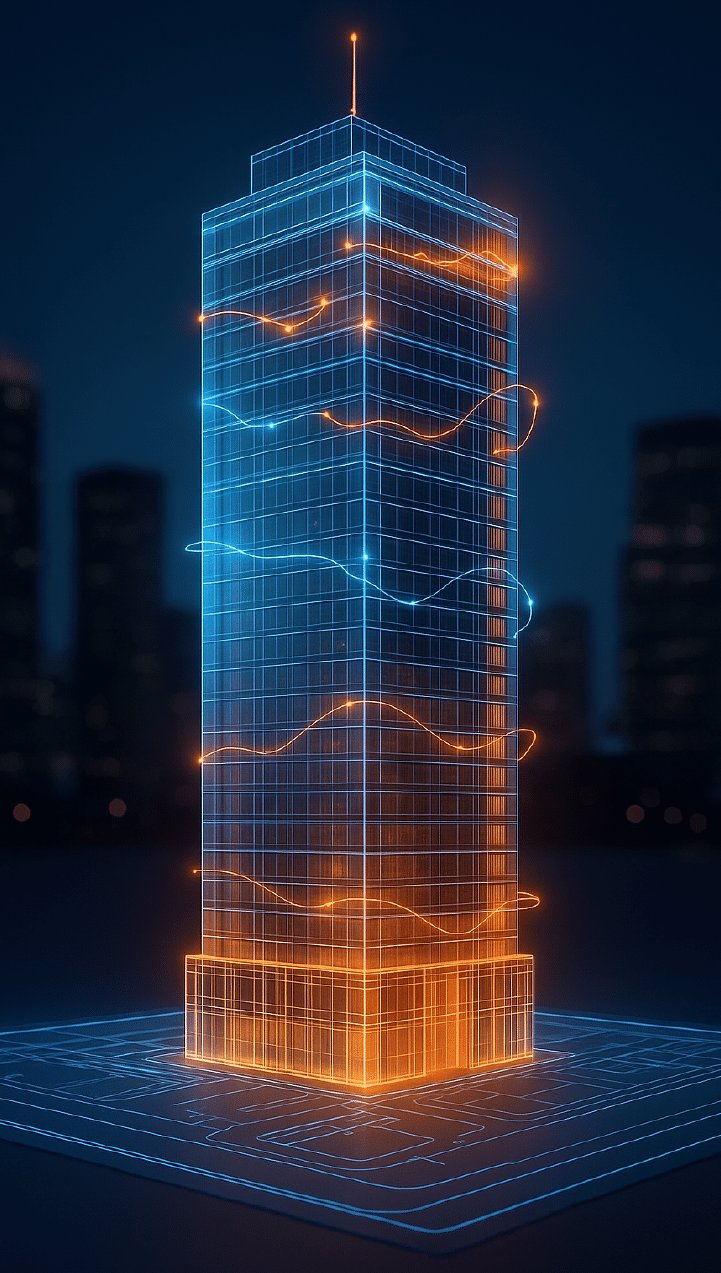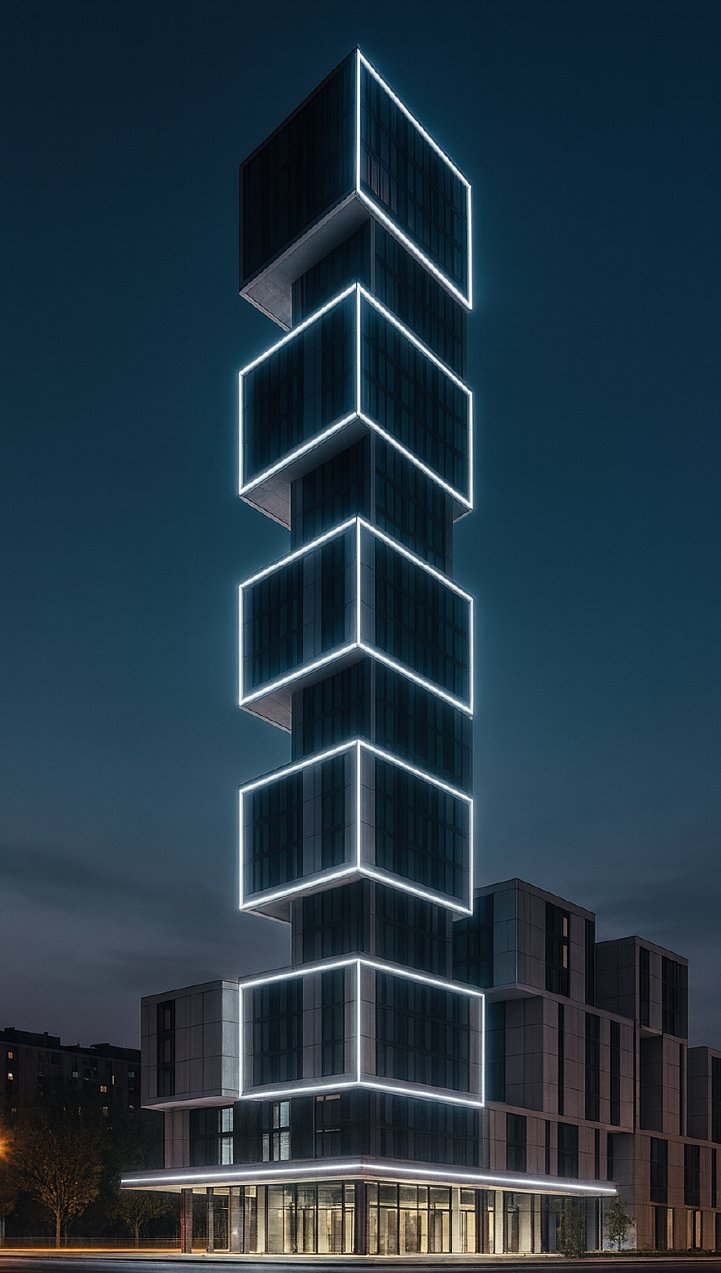Why This Question Matters to Architects Today
The terms Digital Twins and 3D Renderings are often tossed around as if they mean the same thing. They don’t. And for architects, developers, builders, and realtors, understanding the difference isn’t just tech trivia—it’s the kind of knowledge that can transform how you present, manage, and even operate your projects.
Think of it this way: a 3D rendering is like a stunning photograph of your dream home. It’s polished, impressive, and easy to show off. A digital twin, on the other hand, is more like a living, breathing replica of that same home—down to how the HVAC performs on a hot July afternoon or how daylight actually moves through the living room.
Both tools have their place in the modern architect’s toolbox, but they solve very different problems. And if you’re an architect or developer in the United States trying to stay competitive in an Industry 4.0 environment, this is a distinction you can’t afford to ignore.

What Is a 3D Rendering? (The Static Hero)
Let’s start with the old hero of the visualization world. A 3D rendering is a photorealistic digital image of a design. Using advanced software, architects and visualization teams transform CAD or BIM models into images that look as if they were already photographed in the real world.
Where 3D Renderings Shine
-
Client Presentations and Approvals: They help bridge the gap between technical drawings and client imagination.
-
Real Estate Marketing: Developers and realtors use off-plan renderings in brochures, websites, and social campaigns to sell spaces before they exist.
-
Design Visualization: They allow architects and designers to explore how materials, furniture, and lighting interact before construction begins.
Limitations of 3D Renderings
-
They’re static. Once created, they don’t update in real time.
-
They don’t contain operational data—no information about energy usage, occupant behavior, or future performance.
-
They’re snapshots, not living systems.
Example: Imagine you’re pitching a high-rise project in downtown Boston. You create gorgeous renderings of the tower at sunrise, showing golden light spilling into the lobby. Investors are wowed. But after construction, those images won’t tell you how the building’s energy systems will perform on a sweltering August day.
What Is a Digital Twin? (The Living Replica)
Now, let’s move into the futuristic side of the conversation. A digital twin is a dynamic digital replica of a physical building, system, or even an entire city. Unlike renderings, digital twins are data-driven. They don’t just look like the real thing—they behave like it too.
According to McKinsey, digital twins are created by combining BIM models, IoT sensors, and analytics platforms, then connecting everything in real time. That means if your HVAC is overworking, the twin knows. If sunlight is overheating the lobby, the twin knows. If occupancy spikes during an event, the twin adjusts the building systems accordingly.
Levels of Digital Models
-
Level 0: Digital Double – A static geometric model, accurate but limited.
-
Level 1: Extended Double – A static model with added documentation for specific purposes.
-
Level 2: Digital Twin – A fully dynamic model, continuously updated with real-time or archived data.
Where Digital Twins Excel
-
Simulation of Building Behavior: Energy use, sunlight exposure, vibration, airflow, and more.
-
Smart Cities and Heritage Conservation: From Riyadh’s urban twin to Microsoft’s St. Peter’s Basilica project, they’re revolutionizing both modern and historic spaces.
-
Immersive Experiences: When paired with gaming engines like Unreal or Unity, they allow real-time VR/AR exploration and scenario testing.
Example: Picture a digital twin of SoFi Stadium in Los Angeles. It’s not just a pretty model, it integrates crowd movement, energy loads, and even security metrics, allowing operators to manage every event with confidence.

Digital Twins vs. 3D Renderings: Key Differences
| Aspect | 3D Renderings | Digital Twins |
|---|---|---|
| Purpose | Visualization and marketing | Real-time optimization and building management |
| Data | Geometry, materials, and aesthetics | IoT sensors, live analytics, predictive data |
| Interactivity | Limited (rotate, zoom, walkthroughs) | Dynamic simulations, VR/AR, predictive testing |
| Technology | CAD, rendering software, BIM visualization | BIM + IoT + Cloud + AI/ML + Gaming Engines |
| Lifecycle | Early stages (design, marketing, approvals) | Entire building lifecycle (design → operation) |
Simple Analogy:
-
3D Rendering = the perfect photo.
-
Digital Twin = the living avatar that changes with every move.
How Architects and Developers Can Use Each One
3D Renderings Are Best For:
-
Winning Stakeholders: Clients who don’t read plans can finally “see” the vision.
-
Marketing Real Estate: From luxury condos in Miami to suburban homes in Texas, renderings make properties sell faster.
-
Design Communication: Helping interior designers, engineers, and builders stay aligned.
Digital Twins Are Best For:
-
Facility Management: Predictive maintenance for HVAC, lighting, or even elevators.
-
Sustainable Design Optimization: Reducing carbon footprints by testing performance virtually.
-
Large-Scale Urban Projects: Cities like Riyadh and Jeddah use digital twins to model infrastructure, traffic, and utilities.

Why Digital Twins Don’t Replace 3D Renderings
Here’s the truth: these tools aren’t competitors—they’re teammates. A digital twin might be the long-term MVP, but renderings are still the crowd-pleasers at the start of the game.
Think of a developer building a residential complex:
-
Phase 1: 3D renderings are used in brochures and investor decks to secure funding.
-
Phase 2: Once built, the same 3D model evolves into a digital twin, connected to IoT sensors to manage energy use, occupancy, and long-term maintenance.
Without the rendering, you don’t get buy-in. Without the twin, you don’t optimize performance. Together, they complete the architectural journey.
The Future of Visualization in Architecture
If you think digital twins are just a buzzword, think again. Gartner put digital twins at the top of its Hype Cycle in 2018, and by 2027, the market is expected to hit $73.5 billion. That’s not hype—that’s reality.
And what’s driving this?
-
Gaming Engines: Tools like Unreal and Unity aren’t just for Fortnite anymore. They’re now powering real-time, high-fidelity twins for buildings and cities.
-
Industry 4.0: As construction embraces automation, data, and sustainability, digital twins will become the norm.
-
Client Expectations: In a market where buyers expect virtual tours, VR walkthroughs, and data-backed confidence, renderings alone won’t cut it.
For U.S. architects, builders, and real estate professionals, this isn’t optional—it’s the next competitive edge.
How Xpress Rendering Helps You Step Into the Future
While digital twins may sound futuristic, every journey starts with strong visual foundations. At Xpress Rendering, we specialize in high-quality 3D renderings, BIM visualizations, and architectural animations that give architects and developers the clarity they need today—while laying the groundwork for future-ready experiences like VR walkthroughs and even digital twins.
If you’re ready to bridge the gap between static beauty and dynamic performance, we can help.
Explore our 3D Rendering Services or BIM Services to see how we help architects, home builders, and developers prepare for the future of design and construction.
FAQs About Digital Twins vs. 3D Renderings
-
Are digital twins just better versions of 3D renderings?
No. Renderings are powerful visualization tools, while digital twins are real-time, data-driven systems used to manage performance.
-
Do I need digital twins for every project?
Not always. For smaller residential projects, renderings are often enough. For complex, high-value, or long-lifecycle projects, digital twins add immense value.
-
Can my 3D renders evolve into a digital twin later?
Yes. In fact, most digital twins begin as 3D models or renderings, which are then layered with IoT data and analytics.
-
Are digital twins expensive to implement?
They require higher upfront investment in sensors, cloud systems, and data integration. But over time, they reduce maintenance costs, improve efficiency, and enhance sustainability.
-
Where are digital twins being used today?
From smart stadiums like SoFi, to cultural icons like St. Peter’s Basilica, to city-scale planning in Riyadh and Jeddah, digital twins are already changing the way we design, build, and operate.
Conclusion: Digital Twins vs. 3D Renderings
The difference between Digital Twins vs. 3D Renderings isn’t about which one is “better.” It’s about knowing which tool solves which problem. Renderings give us clarity, persuasion, and beauty. Digital twins give us data, performance, and optimization.
For architects, developers, and realtors in the U.S., the smart move is to embrace both—using renderings to win hearts and digital twins to manage the future.
And with Xpress Rendering as your visualization partner, you can have both: compelling renderings today, and a clear path toward the digital twin revolution tomorrow.


